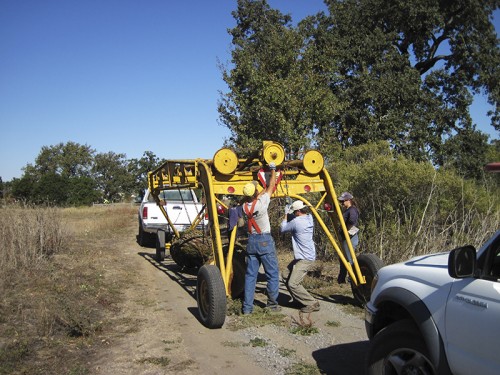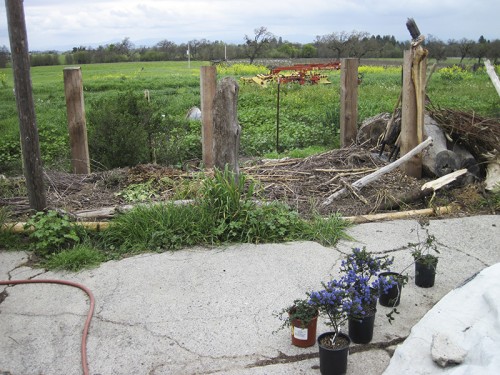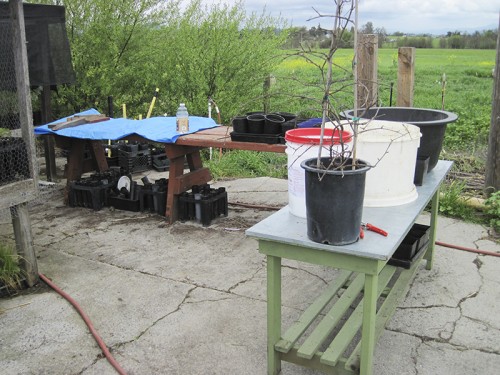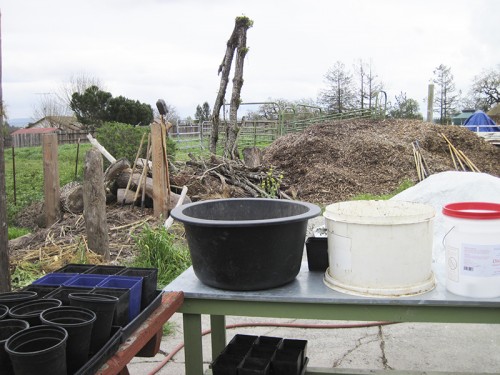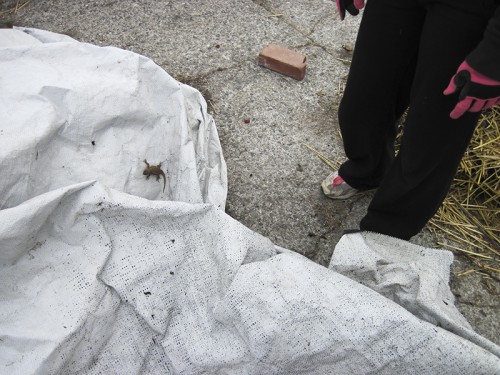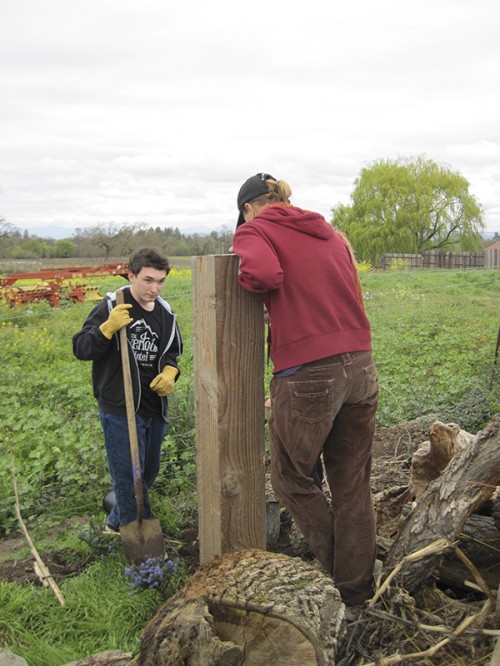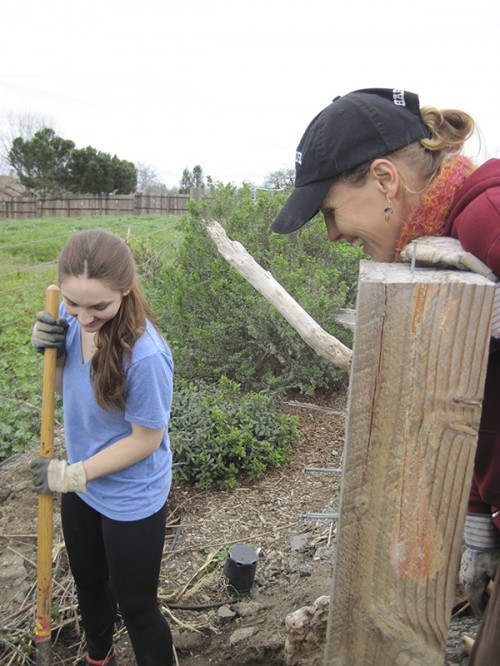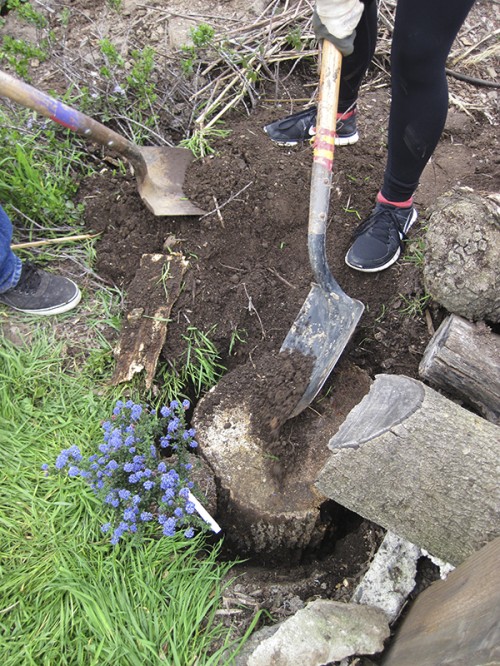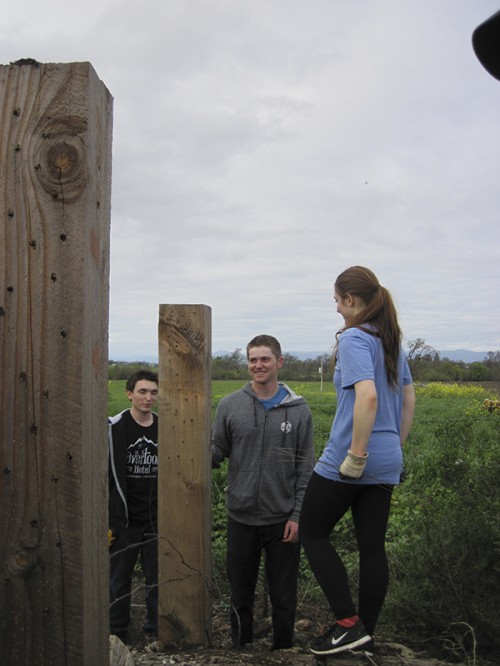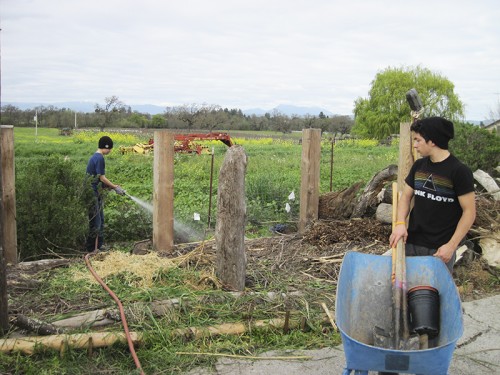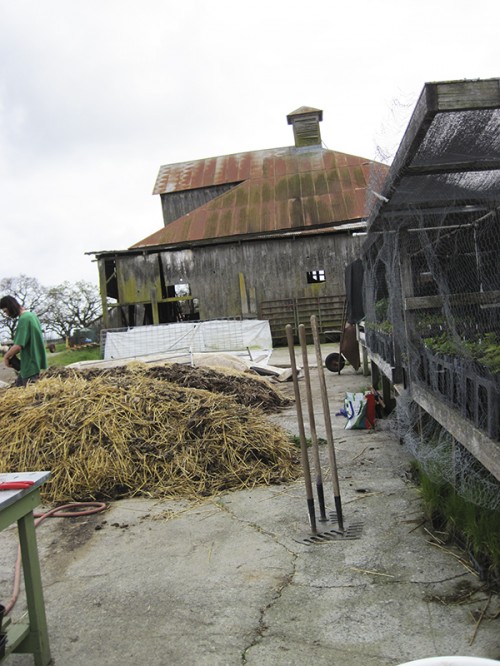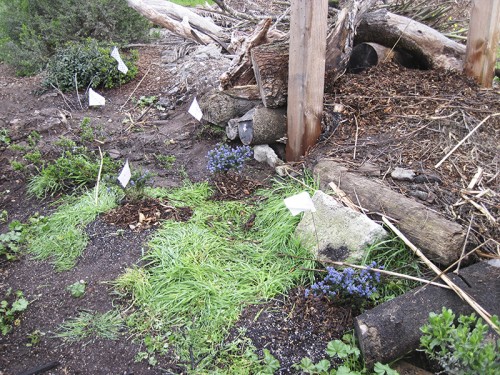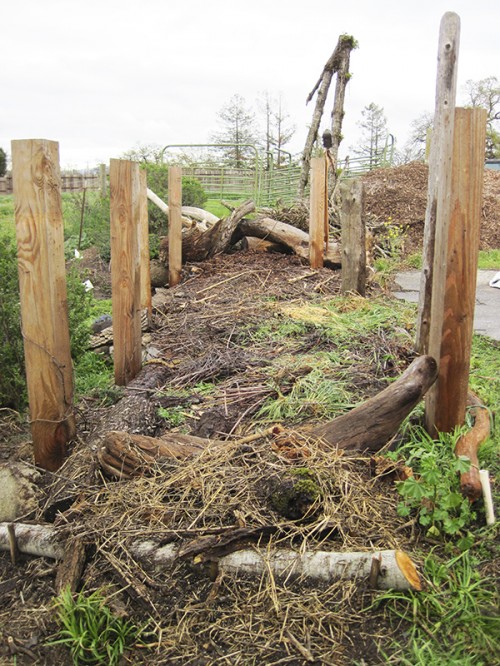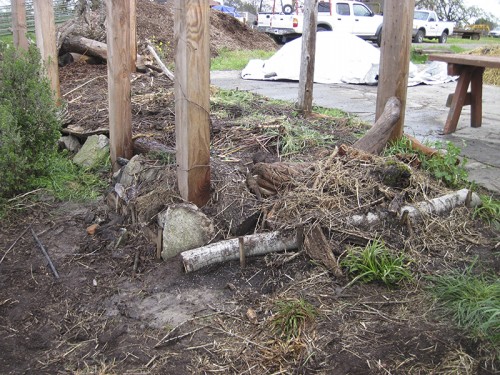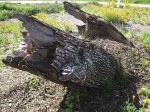
Badger Hole Hollow is a cleanup project turned Wildlife Habitat Installation. This project is an Outdoor Classroom project: Orchard View School; Sunny Galbraith, teacher, and 7 of her Biology students. Location: Laguna Environmental Center. Date of classroom project: April 15th, 2015.
The Laguna de Santa Rosa Foundation operates the Laguna Environmental Center, or LEC, on Stone Farm, at 900 Sanford Road, Santa Rosa, California, 95401. This wildlife habitat installation borders the LEC’s (Laguna Environmental Center’s) Native Plant Nursery, which is used for the Foundation’s Conservation Program.
About 2 years ago, on October 3, 2013, a massive valley oak fell in Doyle Park, Santa Rosa. The City of Santa Rosa had sections of the tree hauled off to one of its wood “graveyards”. The Laguna Foundation coaxed Stone Horse‘s farmer, Stuart Schroeder, to use his implement carrier to bring sections of the huge Doyle Park valley oak to the Laguna Foundation, the purpose being to foster landscape rehabilitation to the Laguna Environmental Center’s fairly recent construction zone around Heron Hall.
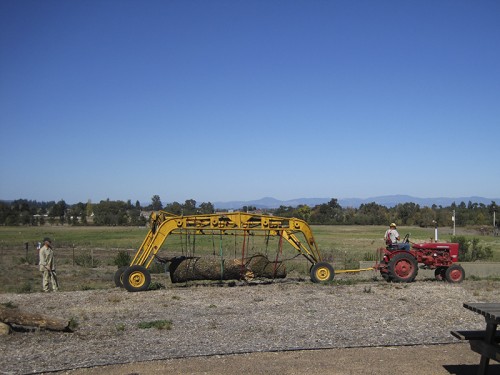 “Just a little to the left and back a bit.” Doyle Park Heritage (valley) Oak section is added to the habitat landscaping of the LEC. Note the implement carrier, with its 4-chain hoist — a flywheel at the head of the metal frame’s roof turns pipes that winds those chains around the pipes. The chains shorten thereby lifting the load. Great way to lift a tree! And move it!
“Just a little to the left and back a bit.” Doyle Park Heritage (valley) Oak section is added to the habitat landscaping of the LEC. Note the implement carrier, with its 4-chain hoist — a flywheel at the head of the metal frame’s roof turns pipes that winds those chains around the pipes. The chains shorten thereby lifting the load. Great way to lift a tree! And move it!
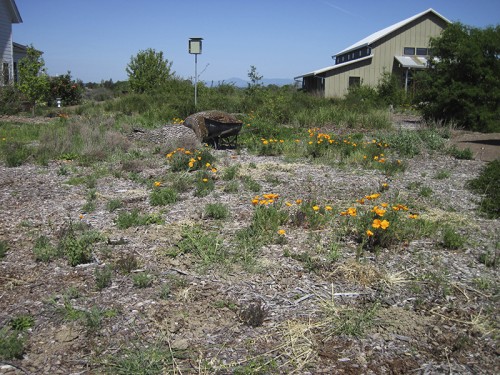 2015. These oak sections, although they will ultimately “return to the earth”, could look more naturally placed in the landscape. They will be repositioned to hide the human-made chainsaw cuts. And in doing so a wildlife habitat will be created.
2015. These oak sections, although they will ultimately “return to the earth”, could look more naturally placed in the landscape. They will be repositioned to hide the human-made chainsaw cuts. And in doing so a wildlife habitat will be created.
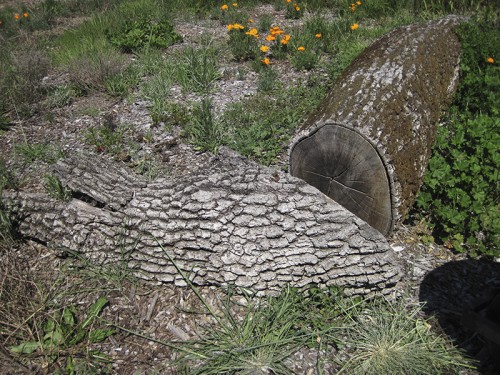 Close-up of BEFORE. Two oak log sections with their chainsaw cuts facing each other.
Close-up of BEFORE. Two oak log sections with their chainsaw cuts facing each other.
A lot to prep before the students arrive. The larger section will be partially buried — the chainsaw cut will sit in a hole and the shredded, more-naturally broken end will twist skyward. One end will create den structure for subterranean animals and the other will provide perch-above-the-grasses for climbing animals and birds. Woodchip mulch is dumped against Trunk (the larger section) 2 weeks before installation date to wick water to the adobe soil below. Softening the soil with moisture will make the digging soooo much easier!
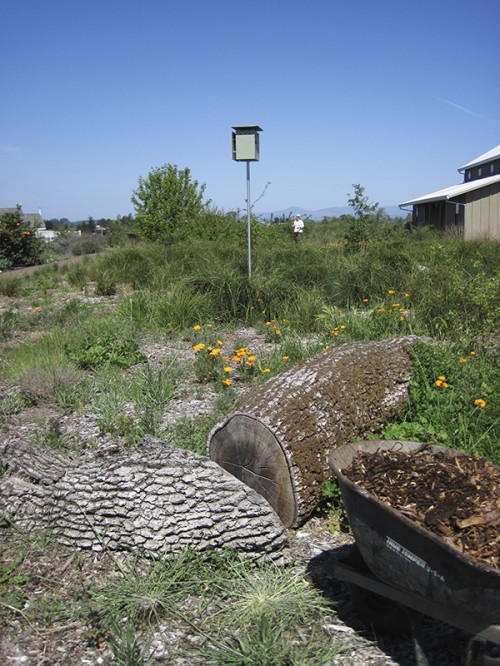 Woodchip mulch is piled up against Trunk (larger section) and watered to moisten the adobe soil 2 weeks prior to digging.
Woodchip mulch is piled up against Trunk (larger section) and watered to moisten the adobe soil 2 weeks prior to digging.
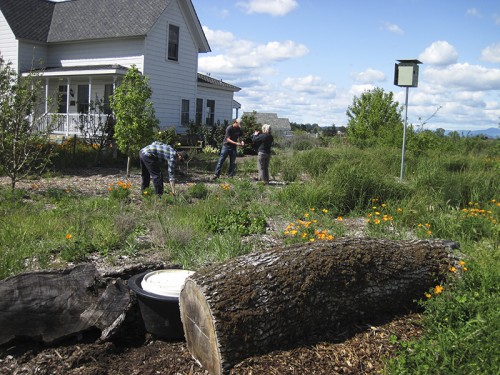 One day before installation date. Staff and an intern discuss pulling weeds. One staffer has a weed by the throat. This native plant landscape will some day be a native plant meadow; till then, weeding is an essential job. Note the soil bins in queue next to the oak logs — they will store soil as the hole for Trunk is dug. Bin 1 = top soil; Bin 2 = layer under the topsoil; Bin 3 = less rich sol, adobe clay; Bin 4 = heavy adobe clay. The bins were labeled as dug and stored to allow the correct bin/soil layer to be returned to the habitat installation at the right time. Preserving the soil layers helps disrupt the soil ingredients less, including critters and soil microbes. Nutrients and critters that were living in the topsoil remain in the topsoil. The same is true for the other soil layers.
One day before installation date. Staff and an intern discuss pulling weeds. One staffer has a weed by the throat. This native plant landscape will some day be a native plant meadow; till then, weeding is an essential job. Note the soil bins in queue next to the oak logs — they will store soil as the hole for Trunk is dug. Bin 1 = top soil; Bin 2 = layer under the topsoil; Bin 3 = less rich sol, adobe clay; Bin 4 = heavy adobe clay. The bins were labeled as dug and stored to allow the correct bin/soil layer to be returned to the habitat installation at the right time. Preserving the soil layers helps disrupt the soil ingredients less, including critters and soil microbes. Nutrients and critters that were living in the topsoil remain in the topsoil. The same is true for the other soil layers.
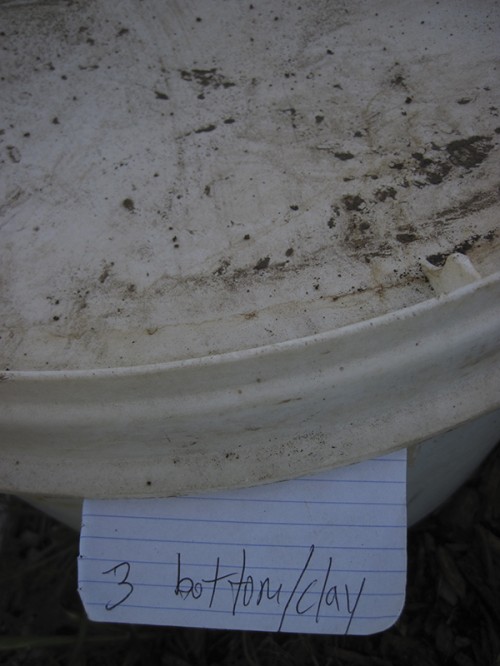 A note labels Bin 3 to sequence when its soil will return to the installation.
A note labels Bin 3 to sequence when its soil will return to the installation.
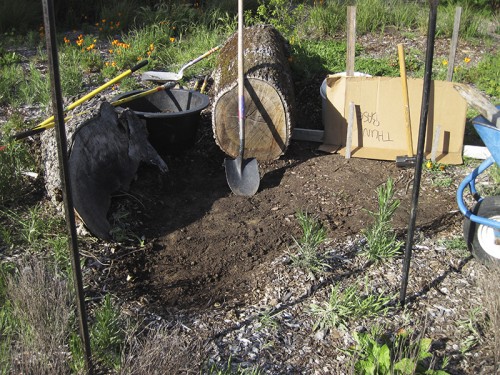 The spade head marks the spot — we will bury our treasure (Trunk) here. The smaller oak tree section, which has been subsequently named “Crocodile”, has been moved out of the way. A cardboard barricade has been temporarily installed to throw dug soil onto; a pile will be created close by to be able to cover over Trunk/hole once Trunk is slid into position, that is, dropped into the hole.
The spade head marks the spot — we will bury our treasure (Trunk) here. The smaller oak tree section, which has been subsequently named “Crocodile”, has been moved out of the way. A cardboard barricade has been temporarily installed to throw dug soil onto; a pile will be created close by to be able to cover over Trunk/hole once Trunk is slid into position, that is, dropped into the hole.
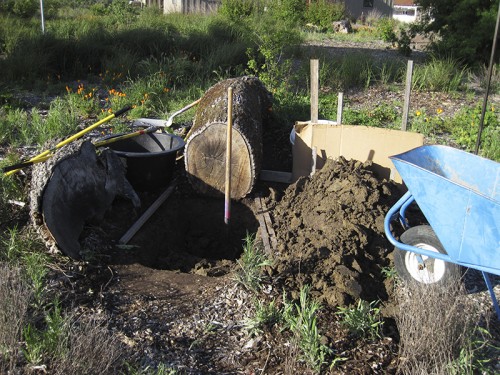 Digging so that Trunk can drop into a hole. The soil pile will return over Trunk, then planted.
Digging so that Trunk can drop into a hole. The soil pile will return over Trunk, then planted.
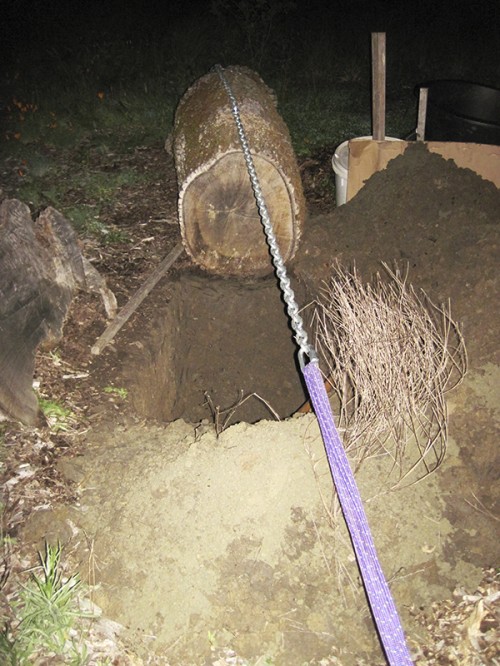 Trunk is coaxed via truck chain into its 4-foot hole rest.
Trunk is coaxed via truck chain into its 4-foot hole rest.
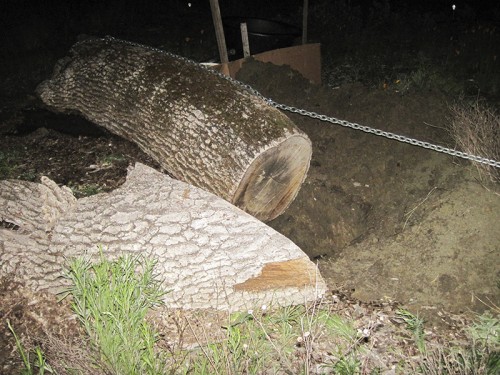 Almost there — time to remove the lower chain bolt. Once the lower bolt was removed, the Trunk was edged vertically into the hole from the chain looped around Trunk’s “top” end.
Almost there — time to remove the lower chain bolt. Once the lower bolt was removed, the Trunk was edged vertically into the hole from the chain looped around Trunk’s “top” end.
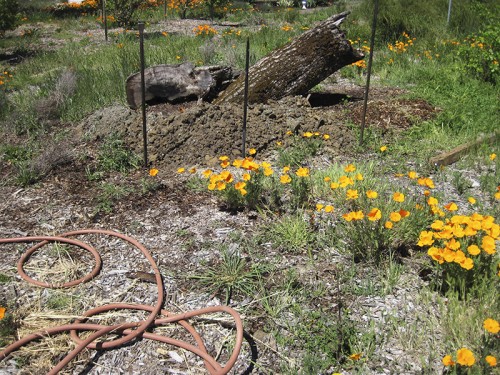 The next morning — installation day for Badger Hole Hollow! The digging bar perimeter will help the students walk carefully around the native plants living alongside Badger Hole Hollow, or “BHH”. Trunk is far enough in the ground it will stay put, minimizing any danger issue. The smaller oak section, Crocodile, will be positioned by today’s Biology class students.
The next morning — installation day for Badger Hole Hollow! The digging bar perimeter will help the students walk carefully around the native plants living alongside Badger Hole Hollow, or “BHH”. Trunk is far enough in the ground it will stay put, minimizing any danger issue. The smaller oak section, Crocodile, will be positioned by today’s Biology class students.
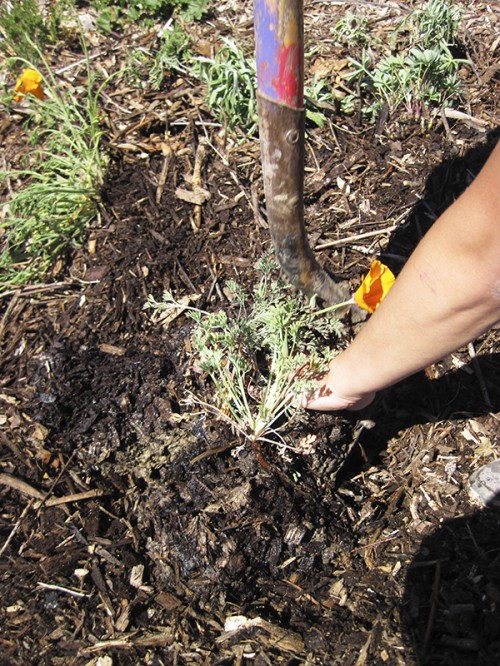 Julia, a student donating her time at the LEC, transplants native plants, like the California poppy (Eschscholzia californica) shown above, to a temporary mound of moist woodchips. The collected plants will be saved from being trampled during the installation and then will be replaced on or alongside Badger Hole Hollow as a finishing touch. If 1 out of 3 or 4 survive the transplant, at least there will be one more native plant to jumpstart the installation.
Julia, a student donating her time at the LEC, transplants native plants, like the California poppy (Eschscholzia californica) shown above, to a temporary mound of moist woodchips. The collected plants will be saved from being trampled during the installation and then will be replaced on or alongside Badger Hole Hollow as a finishing touch. If 1 out of 3 or 4 survive the transplant, at least there will be one more native plant to jumpstart the installation.
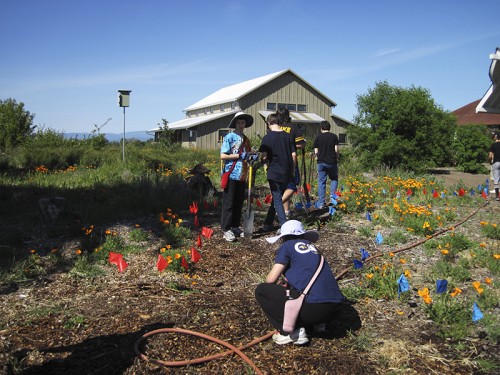 Orchard View students are on site. Red and blue irrigation flags were used to create easily visible walkways between the established (wanted) native plants.
Orchard View students are on site. Red and blue irrigation flags were used to create easily visible walkways between the established (wanted) native plants.
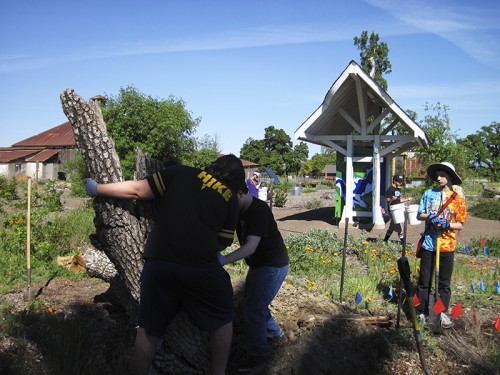 Crocodile wrestling — students position Crocodile into a position that will maximize the wood hulk’s ground surface coverage (for animal shelter) and its landscaping beauty.
Crocodile wrestling — students position Crocodile into a position that will maximize the wood hulk’s ground surface coverage (for animal shelter) and its landscaping beauty.
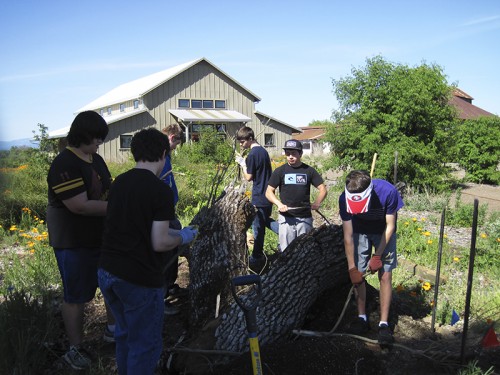 Students break up a stick pile 1) to get rid of the pile of sticks from the compost pile, and 2) to provide organic debris under the habitat installation’s soil planting. Microbes to crawly critters to critters that eat those lower trophic animals will call the small buried stick pile home, habitat.
Students break up a stick pile 1) to get rid of the pile of sticks from the compost pile, and 2) to provide organic debris under the habitat installation’s soil planting. Microbes to crawly critters to critters that eat those lower trophic animals will call the small buried stick pile home, habitat.
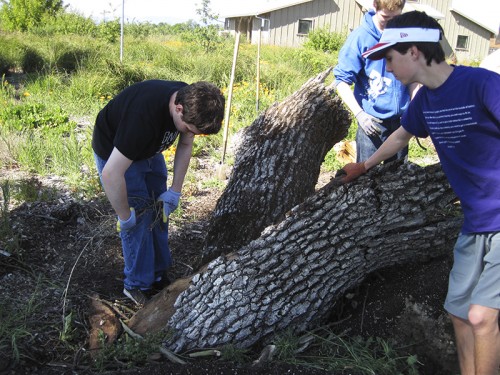 A student breaks up sticks, then uses his body weight to compress the broken stick pile up against Trunk and Crocodile.
A student breaks up sticks, then uses his body weight to compress the broken stick pile up against Trunk and Crocodile.
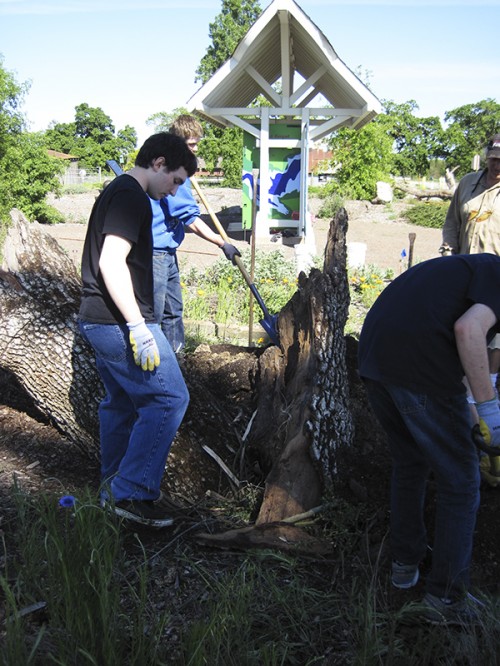 Soil is backfilled (background) and woodchips are mixed into the habitat to prepare for plantings.
Soil is backfilled (background) and woodchips are mixed into the habitat to prepare for plantings.
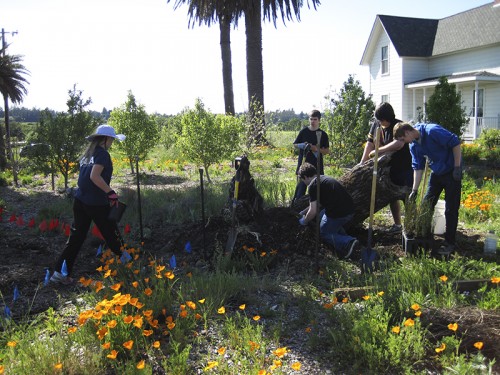 Juncus, or California gold rush (Juncus patens), is planted in between and at the base of Trunk and Crocodile. The juncus, which love moisture, will be on and downslope of the soil/woodchip pile between the 2 oak tree sections.
Juncus, or California gold rush (Juncus patens), is planted in between and at the base of Trunk and Crocodile. The juncus, which love moisture, will be on and downslope of the soil/woodchip pile between the 2 oak tree sections.
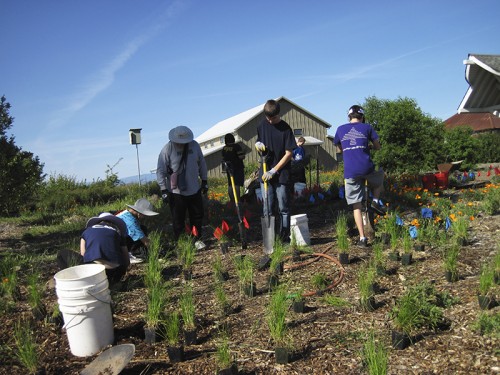 Field sedge (Carex praegegracillus) plugs are planted in the surrounding area of BHH. –Per Wikipedia, “ [Field sedge] tolerates disturbed habitat such as roadsides and thrives in alkaline substrates.” In other words, field sedge is a good choice for our native plant restoration, and subsequent wildlife habitat creation, of this graded soil next to LEC’s road.
Field sedge (Carex praegegracillus) plugs are planted in the surrounding area of BHH. –Per Wikipedia, “ [Field sedge] tolerates disturbed habitat such as roadsides and thrives in alkaline substrates.” In other words, field sedge is a good choice for our native plant restoration, and subsequent wildlife habitat creation, of this graded soil next to LEC’s road.
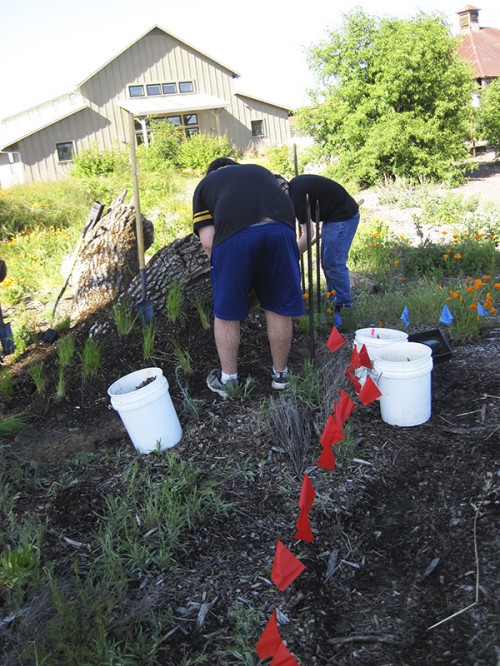 Fields sedge and juncus are planted on Badger Hole Hollow’s hill.
Fields sedge and juncus are planted on Badger Hole Hollow’s hill.
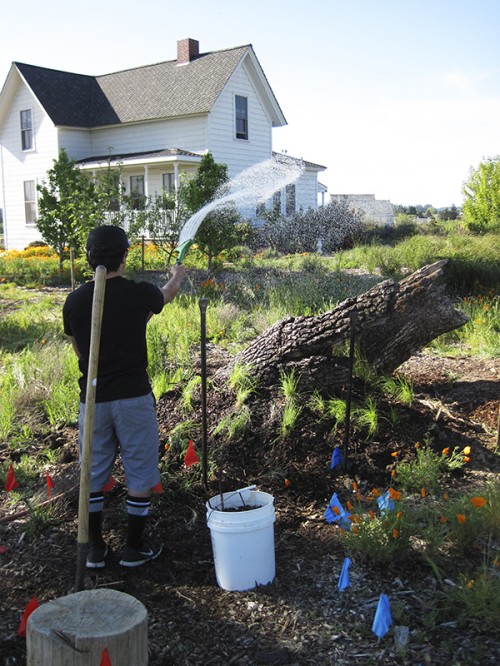 Badger Hole Hollow gets water. This outdoor classroom rocks!
Badger Hole Hollow gets water. This outdoor classroom rocks!
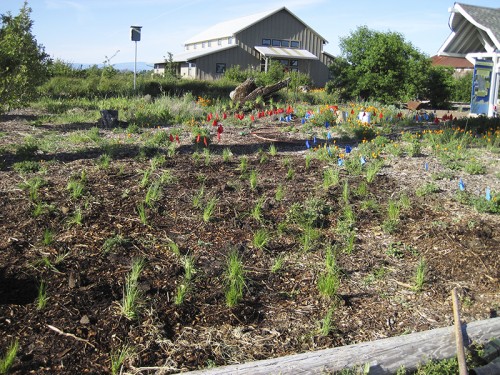 Badger Hole Hollow wildlife habitat has been installed AND field sedge plugs have been planted up to the road’s edge.
Badger Hole Hollow wildlife habitat has been installed AND field sedge plugs have been planted up to the road’s edge.
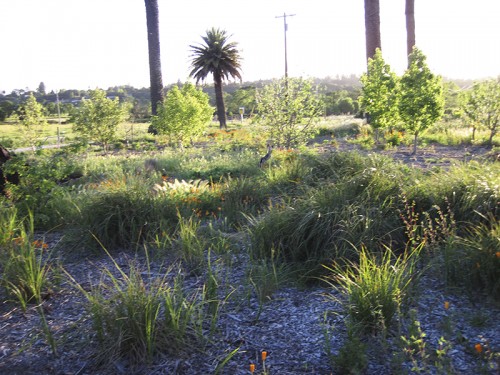 A jack rabbit leaps (center of photo) above the landscape’s sedges and grasses as the project is cleaned up.
A jack rabbit leaps (center of photo) above the landscape’s sedges and grasses as the project is cleaned up.
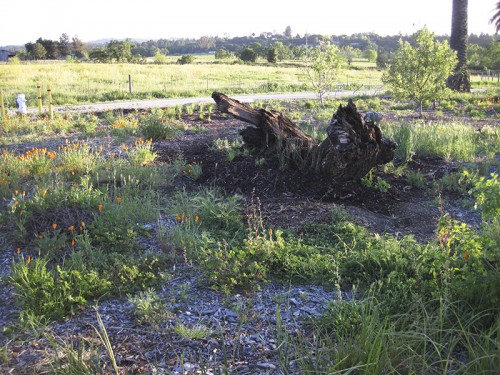 Badger Hole Hollow will rest now and enjoy the sunset.
Badger Hole Hollow will rest now and enjoy the sunset.
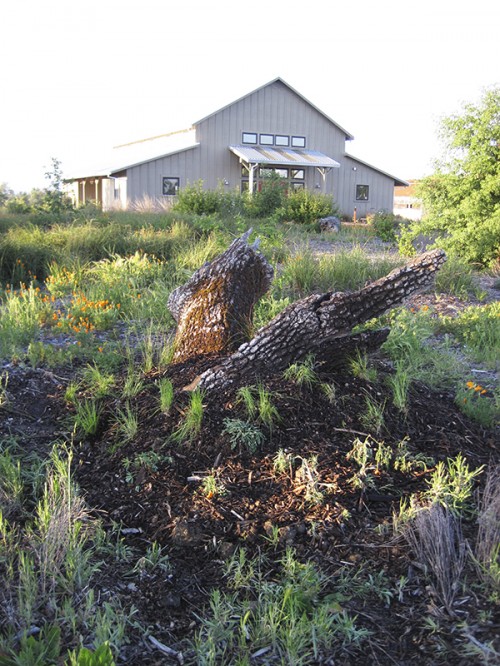 Close-up of AFTER. All in all, Trunk and Crocodile have had a great day.
Close-up of AFTER. All in all, Trunk and Crocodile have had a great day.
Will a badger come to live under or near Badger Hole Hollow? Perhaps, perhaps not, but in the meantime, the critters of the landscape have another option in the terraine.
The students of Orchard View School, teacher Sunny Galbraith, and Cordy and David and I had fun at this outdoor classroom Biology project. A thank you also to the Laguna Foundation’s staff, especially Wendy Trowbridge, Director of Restoration and Conservation Science Programs, and Brent Reed, Restoration Projects Supervisor. Thanks for the plants, Brent. Cool project!
Enjoy your wildlife habitat creations. Habitat it!
Tony
Pics from last month:
[To the Orchard View Students — Sorry I did not get last month’s photos out sooner. I must have had my drill set for REVERSE!]
Native Plants installed in Habitat Garden, March 2015
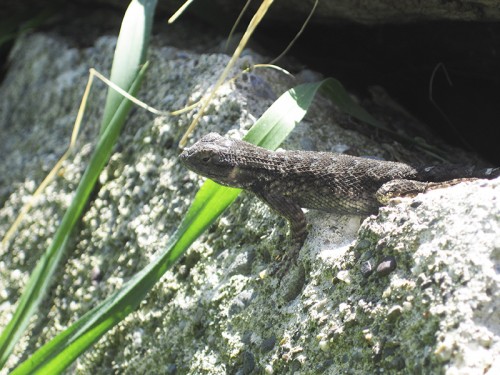 A Western Fence Lizard crawls into the sun from Compost Cricket Corral.
A Western Fence Lizard crawls into the sun from Compost Cricket Corral.

